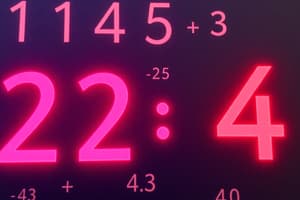Podcast
Questions and Answers
What are imaginary numbers?
What are imaginary numbers?
- Numbers with points on a number line
- Square roots of negative numbers, no points on a number line (correct)
- Only negative numbers
- Only positive numbers
What type of numbers have points on a number line?
What type of numbers have points on a number line?
- Imaginary numbers
- Real numbers (correct)
- Irrational numbers
- None of the above
What are negative numbers?
What are negative numbers?
Numbers less than 0
What are positive numbers?
What are positive numbers?
What is zero?
What is zero?
What are rational numbers?
What are rational numbers?
What are irrational numbers?
What are irrational numbers?
What are radicals?
What are radicals?
What are transcendental numbers?
What are transcendental numbers?
What are integers?
What are integers?
What are nonintegers?
What are nonintegers?
What are natural/counting numbers?
What are natural/counting numbers?
What are digits?
What are digits?
What are even numbers?
What are even numbers?
What are odd numbers?
What are odd numbers?
What are axioms?
What are axioms?
What are polynomials?
What are polynomials?
What is the degree of a polynomial?
What is the degree of a polynomial?
What is an extraneous solution?
What is an extraneous solution?
What is the reflexive property?
What is the reflexive property?
What is symmetry in mathematics?
What is symmetry in mathematics?
What is transitivity in mathematics?
What is transitivity in mathematics?
What is trichotomy?
What is trichotomy?
What is a lemma?
What is a lemma?
What is a theorem?
What is a theorem?
What does 'or' mean in an equation?
What does 'or' mean in an equation?
What does 'and' mean in an equation?
What does 'and' mean in an equation?
Flashcards are hidden until you start studying
Study Notes
Imaginary and Real Numbers
- Imaginary numbers are square roots of negative numbers with no corresponding points on the number line.
- Real numbers have defined locations on the number line and include all rational and irrational numbers.
Types of Numbers
- Negative numbers are values less than zero; examples include -1 or -5.
- Positive numbers are values greater than zero; examples include 1 or 7.
- Zero is a unique number that is neither positive nor negative.
Rational and Irrational Numbers
- Rational numbers can be expressed as a ratio of two integers; examples include 1/2, 2, or -6/12.
- Irrational numbers cannot be expressed as a ratio of integers but are real; examples include √5 and π.
Radicals and Transcendental Numbers
- Radicals involve square roots, cube roots, etc., of integers; for instance, √5.
- Transcendental numbers cannot be expressed as the root of any integer; π is a primary example.
Integer and Non-Integer Types
- Integers encompass whole numbers and their negatives, such as 2 and -2.
- Nonintegers include fractions or numbers that fall between integers, e.g., 3/4 and -7/10.
Natural and Counting Numbers
- Natural (counting) numbers are the set of positive integers starting from 1.
Number Classification
- Digits range from 0 to 9, forming the basis of numerals.
- Even numbers are integers divisible by 2, such as 2 and -4.
- Odd numbers are integers not divisible by 2, such as 3 and -5.
Mathematical Properties
- Axioms are fundamental mathematical properties like closure, commutativity, associativity, identity elements, inverses, and distributivity.
Polynomials
- Polynomials are algebraic expressions formed by the addition, subtraction, or multiplication of variables.
- Types of polynomials based on the number of terms include monomial (1 term), binomial (2 terms), trinomial (3 terms), and polynomial (4 or more terms).
Degree of Polynomial
- The degree of a polynomial indicates the highest number of variables as factors in any term.
- Degrees include: 0 (constant), 1 (linear), 2 (quadratic), 3 (cubic), 4 (quartic), and 5 (quintic).
Solutions and Properties
- An extraneous solution satisfies a transformed equation but not the original.
- The reflexive property asserts that any number is equal to itself (x = x).
- Symmetry states that if x equals y, then y equals x.
- Transitivity defines equality as if x = y and y = z, then x = z; and for order, if x > y and y > z, then x > z.
- Trichotomy states that for real numbers x and y, one and only one of the conditions holds: x > y, y > x, or x = y.
Theorems and Logical Connectives
- A lemma serves as a minor result aiding in the proof of more complex theorems.
- A theorem is a proven mathematical statement applicable in further calculations.
- The logical connective Or allows for possibilities where an equation is greater than or equal to x or less than or equal to -x.
- The logical connective And constrains an equation to being less than or equal to x or greater than or equal to -x.
Studying That Suits You
Use AI to generate personalized quizzes and flashcards to suit your learning preferences.




